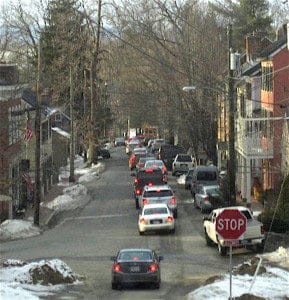
Commuter Traffic is a Threat to Waterford
This article appeared in the March 13, 2016 issue of LoudounNow.
Written by the Waterford Citizens' Association
Evening Rush Hour in Waterford
Historic Waterford is known for its bucolic scenery, well-preserved 18th and 19th century buildings and, more recently, the overwhelming amount of traffic it sees during rush hours.
Thousands of commuters cut through the once peaceful village daily on their way to Main st back up by Maryand from work—so many that locals joke about the "parades," and visitors can't safely enjoy a walk during peak commuting times. Waterford's narrow, quaintly askew historic streets are being asked to do the job of major transport arterials. The situation poses a grave risk to one of the most treasured heritage sites in Loudoun County and the country, and threatens the safety of commuters and residents.
Even among landmarks, the village is special: it's one of only three National Historic Landmarks that encompass entire towns. The well-known Waterford Homes Tour and Crafts Exhibit, for which the village closes its streets to cars, attracts tens of thousands of visitors over three days each October and contributes $4.5 million to Loudoun County's economy annually.
But many of the features that brought Waterford recognition through our country's highest historic designation are now altered by steady streams of traffic. Historic Waterford's status as a village largely unchanged from its 18th and 19th century appearance is threatened.
The more than 3,000 vehicles that pass through Waterford daily have also made the streets dangerous for commuters, residents, their children and visitors. At the Post Office intersection alone, peak traffic rates are approximately 280 per hour in the morning, and 360 per hour in the evening. At least five crashes have been documented in the village in the past year.
The problem will only get worse as the area continues to grow. Loudoun County projects that, by 2020, there will be a 30 percent increase in the number of housing units compared with 2010 census figures. The Maryland and West Virginia communities that generate a portion of Waterford's cut-through traffic are also expected to experience growth. A few misconceptions have made it difficult to solve Waterford's traffic problem:
"Commuters have nowhere else to go." Commuters can take Rt. 287 and Rt. 9, major arterials designed for moving large volumes of traffic, just as they did before Milltown Road was paved.
"Cutting through Waterford is a shortcut." It actually takes more time to drive through Waterford than to take Rt. 287 and Rt. 9. Cutting through may seem quicker because there are no stoplights, but it's not.
"Waterford's streets can be widened to accommodate more traffic." Waterford's narrow roadways were designed centuries ago to accommodate horse and carriage traffic. Today, they are integral to Waterford's protected heritage. Many of the historic buildings sit just a few feet from the edge of the existing roadway. The Old Mill, a building considered by some to be Waterford's crown jewel, is just 23 inches from the edge of First Street.
"There is nothing we can do to cut down on Waterford's traffic." Residential areas in Virginia and elsewhere route traffic so that commuters get to their destinations and residents have safe streets. There has been a plan to do just this in Waterford for a long time. The county-approved 1987 Waterford Area Management Plan recommends circulation of local traffic only, and provides detailed road improvements to enhance flow on the main roads that bypass the village. A 2003 consultant study endorsed by village residents and other stakeholders made similar recommendations.
So what are the next steps?
The county government and the Virginia Department of Transportation have agreed that Waterford's growing traffic volume is in part a commuter cut-through problem. The supervisors will be asked this month to approve funding for a study to determine whether Waterford meets criteria for solutions available under VDOT's Control of Residential Cut-Through Program.
The Traffic Committee of the Waterford Citizens' Association is examining choices made in other communities, and widely consulting within and outside the village, including a Historic Villages and Rural Roads Workshop this summer, sponsored by the Loudoun County Preservation and Conservation Coalition, the Waterford Foundation and the WCA.
The daily deluge of traffic in Waterford is endangering the village's landmark status as well as the safety of commuters, area residents and visitors. We hope Loudoun residents will help us urge the county to enact a plan to keep our historic streets scenic and safe. Please contact your Board of Supervisors representatives at 703-777-0204 and urge them to support the goals of the 1987 traffic management plan for Waterford.
[The Waterford Citizens' Association was established in 1954 to support the citizens of the Waterford School District in the preservation of the historic heritage and to promote citizen involvement in the Waterford community. In Our Backyard is compiled by the Loudoun County Preservation and Conservation Coalition. To learn more about the organization or to participate in the rural road initiative, to go loudouncoalition.org.]